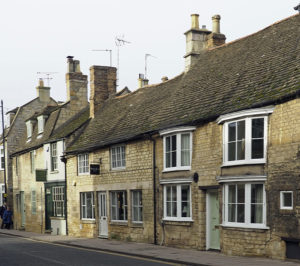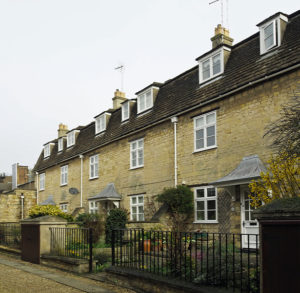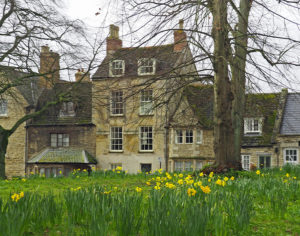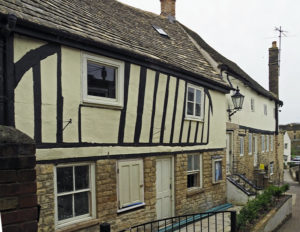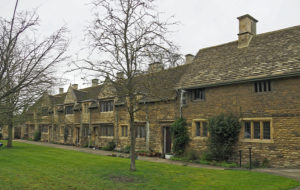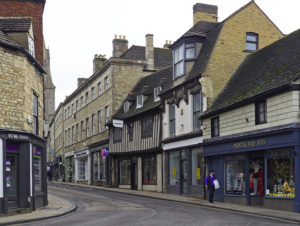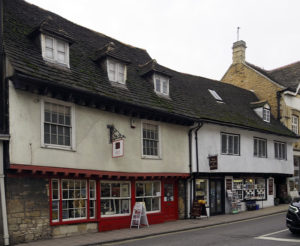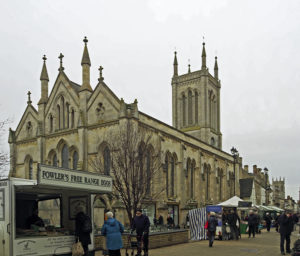Seen from the A1, Stamford is an attractive stone town dominated by the towers and spires of its Medieval churches and surrounded by fertile Lincolnshire countryside. It rivals the stone towns and villages of the Cotswolds, and like them, its prosperity was based on wool.
Stamford has a long history as an important crossing point on the River Welland. It was an important Saxon burgh, and one of the 5 controlling boroughs of Danelaw. It was one of the first towns to produce glazed wheel thrown pottery after the Romans had left Britain. It even had its own mint and examples of the coins can be seen in the Town Hall.
It prospered under the Normans who built a castle here to protect the ford crossing and a wall around the town. Little now remains of this apart from part of a wall at the junction of Castle Dyke and Bath Row It became a centre for the hearing of law cases by the King’s Justices and the town was frequently visited by monarchs on affairs of State, when Parliaments and other councils convened in the town.
The economy based on wool thrived. Stamford was particularly famous for a woven cloth called haberget, which had a rough diamond texture and finish. It was made in different qualities with the cheapest being used by the poor, and the very fine cloth by the wealthy.
It had good communications along the River Welland to the Wash and Europe as well as along the Great North Road to the rest of the country. By the C13th, it was one of the ten largest towns in England with six monasteries and priories and 14 churches. For a short time in the C14th it even had a University, formed by a group of breakaway students from Oxford University.
A few of the original half timber timber frame buildings can still be seen around the town. As the town became more wealthy, these were rebuilt in stone from local quarries with Collyweston slate roofs. Some buildings were just given a new frontage and the remains of the original timber frame can be seen behind.
In the late C15th/early C16th the River Welland began to silt up and the centre of the wool trade moved to East Anglia, leading to a decline in the prosperity of the town, with wealth being concentrated in the hands of a few rich merchants. They paid for the rebuilding of many churches in the C15th, as well as hospitals and alms houses for the poor. Browne’s Hospital and the Lord Burghley Hospital are good examples. This was originally established in the late C12th by Peterborough Abbey to provide accommodation for travellers as well as the local poor and sick. After the Dissolution of the Monasteries, it was bought by Lord Burghley as almshouses for both men and women who have lived and worked in Stamford, and it still does today.
In 1622 James I authorised the the building of a (now disused) canal between Stamford and Market Deeping to restore navigation to the Wash. Improvements to the Great North Road and in particular the arrival of the Turnpike Trusts in the early C18th led to a renaissance in trade. Midway between London and York, Stamford became an important staging post one day’s travel from each. Gateways in the town walls were pulled down and the road became lined with coaching inns. The George Hotel is a reminder of this time and still has its sign across the road to attract the attention of coach drivers and make them stop.
Professional men and wealthy merchants were attracted to the town and built many of the splendid stone houses seen today date from the C18th. Rutland Terrace on the western outskirts of the town is a particularly fine example and worthy of anywhere in Bath. With its views across open countryside, it was It was targeted at those who wanted to escape living in the town centre.
The arrival of the railways in the C19th dealt a death blow to further development when the Third Marquis of Exeter who lived in Burghley House on the outskirts of Stamford refused to let the railway companies build a railway line across his land. From being an important staging point, Stamford became a rural backwater, and escaped the blight of C19th and early C20th development.
The town still retains its Saxon street plan with many small alleyways, and many of the population still live in the town centre. In 1967 Stamford became the first urban conservation area in England and is popular with film makers. It is a regular finalist in The Sunday Times the best place to live in Britain survey.
With its pedestrianised street and range of different architectural styles it is an attractive place to wander. All the large supermarkets are here on the edges of the town. The town centre retains a mix of chains stores as well as small specialist shops, which have been family owned for generation. The Friday market with its excellent range of food stalls on Ironmonger and Broad Street, over looked by the redundant St Michael’s Church attract visitors from all over the local area.
